 |
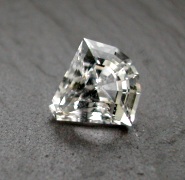 |
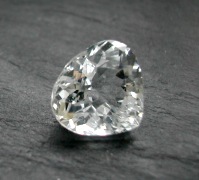 |
| 2.69ct
8.1x8.1mm 2.66ct
10.1x9.8mm Brazil |
3.46ct
11x10mm Pakistan | |
緑柱石(Beryl)
2.ゴッシェナイト(Goshenite)
 |
 |
 |
| 2.69ct
8.1x8.1mm 2.66ct
10.1x9.8mm Brazil |
3.46ct
11x10mm Pakistan | |
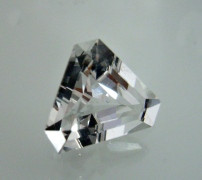 |
 |
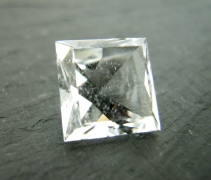 |
 |
| 1.53ct 8.15mm | 2.80ct ø9.45mm | 2.50ct 7.70mm | 2.62ct 9.95x7.70mm |
| Greenwood, Maine, U.S.A. | |||
 |
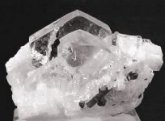 |
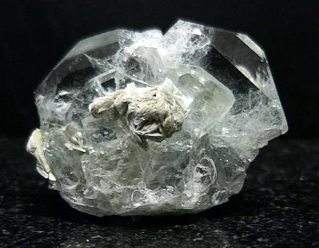 |
 |
| 7x4cm Labvra de Criminoso | 3x2x1.5cm Resplendor | 42x31x24mm, Taquaral | 55x35x35mm |
| Minas Gerais, Brazil | 雪宝頂山, Xuebaoding Mtn. | ||
| Ecole de Mine Collection, Paris | Sichuan, China | ||
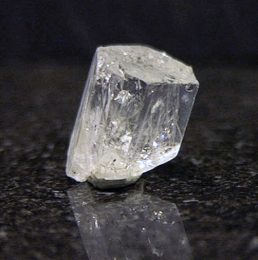 |
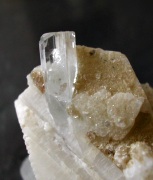 |
 |
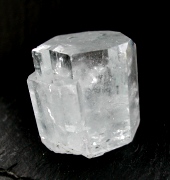 |
| 15x10x11mm Colombia |
Goshenite on
Orthoclase (10mm) Shigar Valley Pakistan |
2.3x1.4x1.1cm Chumar Bakar Nagar, Pakistan |
22x21mm Mogok Burma |
雪宝頂山の鉱物 (Minerals of Xuebaoding Mtn., China)
 |
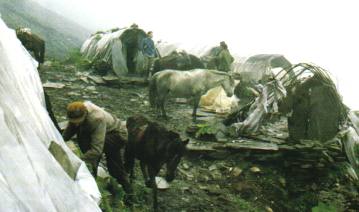 |
 |
| 雪宝頂山(Xuebaoding Mtn.)5588m
中国四川省 |
採掘キャンプ 標高3900m Zibaisha Mining Camp |
Location of
Mine Sichuan, China |
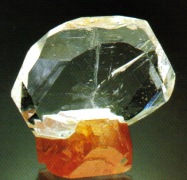 |
 |
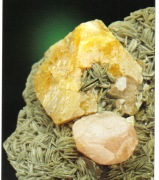 |
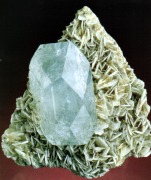 |
| 灰重石上のゴッシェナイト Goshenite 3cm on sheelite |
白雲母上の錫石とモルガナイト Cassiterite and Morganite on Muscovite |
灰重石とモルガナイト
3.2cm Sheelite and Morganite |
白雲母上のアクアマリン
9.3cm Aquamarine on muscovite |
ゴッシェナイトは不純物が非常に少ない,ほぼ純粋な成分の無色の緑柱石の呼び名です。
この名前は1844年にアメリカ、マサチューセッツ州のゴッシェン (Goshen) のペグマタイト鉱脈で発見された無色の緑柱石に因んで命名されました。
アメリカ東海岸の北東部からカナダのケベック州にかけては広大なペグマタイト地帯が広がっていて、何故か他のペグマタイト地帯には少ないゴッシェナイトやポルックス石等、無色透明な宝石が発見されます。
冒頭のメイン州産グリーンウッドもそうした産地の一つです。
緑柱石はペグマタイト鉱脈に普通に発見される鉱物ですが,殆どの結晶は鉄やマンガン等の不純物を含んで淡緑、淡青、黄色,金色、ピンク等の色を持ちます。不純物がごく少ないか殆ど含まない緑柱石が無色透明のゴッシェナイトと呼ばれます。
したがって無色のゴッシェナイトは大変珍しく、世界に数あるペグマタイトでも宝石質の結晶が発見されることはなかなかありません。
透明な結晶は宝石コレクター用にカットされます。
緑柱石の屈折率は1.58前後と低いのですが、ゴッシェナイトのルースはまるで氷のように透明で強い煌きを放ちます。
がしかし、如何に美しかろうと、無色透明な宝石はサファイアであれ,トパーズであれ、スピネルであれ、今日ではダイアモンド以外は一般には全く人気がありません。
したがって大半はコレクターの収集品となり、宝石店で見かける事はありません。
透明な宝石級の結晶は,世界でもブラジル,ミナスジェライスのタカラル(Taquaral) と、その周辺の鉱山に集中している様です。
A pure, colorless beryl is called Goshenite, which name deribes from colorless beryl found at pegmatite vein near the town of Goshen, Massachusetts, U.S.A., in 1844. North-eastern area of North America is rich in pegmatite veins and rare transparent colorless gemstones, such as goshenite and polucite are found abundantly. Greenwood, Maine is one of such locality.
The beryl is a common mineral found at magmatic hydrothermal veins and is generally colored green, blue,blue-green, yellow, gold, pink, emerald green, due to impurity. Colorless beryl, goshenite is rare and gem quality, transparent and cuttable crystals have been known fromTaquaral area, in Minas Gerais, Brazil. Despite it's low refractive index of 1.58, icy transparent goshenite is attractive for its brilliant dispersion . But goshnite is cut only for gem collectors and is never used for jewellry.
Because of the dominant position of Diamond in jewellry business, all other colorless stone ; sapphire, topaz, spinel etc., are not popular at all as gemstone. They are cut only for gem collectors.
一般に緑柱石は完全な六角柱状の結晶で産出します。
ところがモルガナイトとゴッシェナイトにはむしろ平板状の結晶がよく見られます。
その理由は何故かと考えてみるに、微妙な成分の違いが関与しているのではないかと思われます。
ゴッシェナイトやモルガナイトにはベリリウムの一部がセシウムと置き換わっている例が報告されています。 ベリリウムはIIA族の元素ですが、セシウムはIA族に属し、全元素中で最も電子親和力が小さい元素です。このような元素と置き換わると、結晶格子間のエネルギー・バランスが変り、a−b 軸の成長が促進されて結晶が平板状に成長するようになるのかもしれません。
冒頭の写真の2列目は平板状のゴッシェナイト結晶です。
2000年の世界の鉱物・宝石フェアでは中国,四川省の奥地に聳える標高5588mの雪宝頂山 (Xuebaoding) の中腹、4480m地点のペグマタイト鉱脈に灰重石や錫石、ピンクの蛍石等と共に産するゴッシェナイトがかなりの量出回っていました。
入手した結晶が、手元にあったブラジルのタカラル産とそっくりの形状だったのには驚きました。
この地点はおよそ 1億 8千 700 万年昔の地殻変動によりペグマタイト性の鉱脈が形成されたと考えられています。
30年ほど前に鉱脈が発見され、かつては主にタングステンや錫等の重金属鉱山として雪のない5月から10月の期間採掘が行われていました。
しかし10年ほど前からは、写真のような結晶の価値が世界的な注目を集めるようになり、現在では5月から10月の期間 , 100人ほどの鉱夫が主に結晶の採掘に専念しています。
Generally, beryl is found as prismatic hexagonal crystal, while morganite and goshenite are often found as tabular crystal form.
The reason seems to be its chemical composition. Goshenite and Morganite are known for its relatively high Cesium contents replacing Beryliumu. Beryllium belongs to IIA group elements , while Cesium belongs to IA group and its value of electron affinity is the lowest among all elements. When Beryllium is replaced by such elements, probably the the slight change of energy balance in beryl crystal latice promote the crystal growth in the direction of a-b axes.
Photos of top row are examples of tabular crystal. At world mineral markets of the year 2000, appeared goshenite-aquamarine crystal from Pegmatite mine at the elevation of 4480m of Xuebaoding Mtn.(5588m)
Sichuan, China. The mineralization is considered to have been occured about 187 Million years ago. And the minning started about 30 years ago. In the past, the mine was operated for tungusten and tin minerals, but recently about 100 miners work during summer time( May to October), mainly for world renowned crystal collection.
2段目はいずれも6角柱状のゴッシェナイトの結晶写真です。
最初の写真は何とコロンビアのエメラルド鉱山からのものです。
たまたまクロムも他の不純物も含まない純粋な緑柱石が結晶したのでしょう。
次の二つの結晶はいずれもパキスタン産です。
パキスタンの緑柱石はモルガナイト結晶は平板状ですが、アクアマリンとゴッシェナイトとは6角柱状の結晶となるようです。
ビルマのモゴクは最も美しいルビーやサファイアの産地として有名ですが、実はペグマタイト鉱脈もあって、緑柱石やトルマリン等も一緒に採れるという驚くべき地層の土地です。
スリランカでも同様にルビーやサファイアと共にアクアマリンやトパーズ等のペグマタイト鉱物が採れますが、これは数億年昔に全く別々の場所に出来た鉱物が、永年の風化作用の後に漂砂鉱床として偶々同じ場所で発見されるためです。
ところがモゴクの場合は、ルビーとサファイアとが出来た変成鉱床地帯に、時間的には異なりますが、ペグマタイト鉱脈が貫入してほぼ同じ場所で地層や成因の異なる宝石が採れるという、世界でも珍しい宝石産地なのです。
2nd row phots are all prismatic hexagonal goshenite crystals : 1st is an extreme rare goshenite from Colombian emerald mine.
Next two goshenites are from Pakistan, where a tabular morgnite is common but aquamarin and goshenite shows prismatic crystal from. The last is a goshenite from Mogok, Burma, a famous producer of Ruby and Sapphire. But Mogok produces tourmalines, topaz and beryls, typical pegmatite origin gems, too. From geological point of view, Mogok is a quite interesting location, where gems of different geological origines are found at the same area. In Srilanka, gems of different origins are found but it is an alluvial deposit and origines of gems are far apart from the deposit.